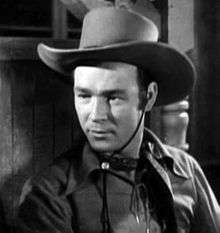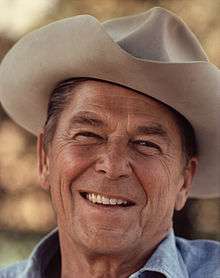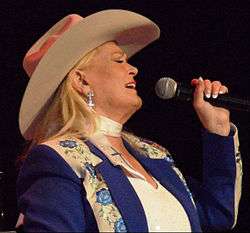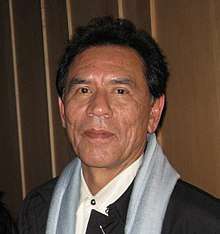Western lifestyle

Western lifestyle or cowboy culture is the lifestyle, or behaviourisms, of, and resulting from the influence of, the (often romanticized) attitudes, ethics and history of the American Western cowboy and cowgirl.[1] In the present day these influences affect this sector of the population's choice of recreation, clothing, and consumption of goods. Today, the Western lifestyle is considered a subculture and includes strong influences from Native American and Mexican American, as well as aspects of African American and Asian American cultures.
Origins
The origins of cowboy culture go back to the Spanish who settled in New Mexico and later Texas bringing cattle.[2] Prior to the 19th century, ranchers were primarily Spanish while those working it were Indigenous. By the late 1800s, one in three cowboys were Mexican and brought to the lifestyle its iconic symbols of hats, bandanas, spurs, stirrups, lariat, and lasso.[3] With westward movement brought many distinct ethnicities all with their own cultural traditions. Welsh Americans, as one example, had a history in Wales of cattle and sheep droving, that incorporated well into ranch work.[4]

A common misconception is in relating Country to Western or vice versa. While the two may have similarities such as the music being based on folk singing, they are in fact uniquely different. For example, the sound of Country originates from Appalachia where immigrants of the British Isles settled in the hills of the south-east United States. Prior to the coining of the phrase "Country & Western" in 1956, Country was in large part known as Hillbilly music. On the other side, Western music derives from the area west of the Appalachia and ties into cowboy culture originally from Mexico but today spreads in the western states and parts of Western Canada.[5] In the mid-20th century fusion of the two genres occurred with many musicians applying aspects of both genres into their song repertoire.
Dime novels
Beginning in the 1860s, dime novels began sharing erroneous and highly romanticized tales of the West, feeding the public's interest in the trade and life West of the Mississippi.[6]
Radio, Film and Television
Throughout the 20th century, radio, film and television had a profound affect on the fashion and mannerisms that built the foundation of what it meant to be living a Western lifestyle, however most of this was more Hollywood glitz and glamour than historical narrative.[7]
Revival
In the 1980s, following the urbanization of much of the Texas population, there was a marked revival of cowboy culture with the creation of a number of organizations devoted to its preservation, among them the American Cowboy Culture Association.[8]
Notable people
The following is a list of notable people who lived or are living a Western lifestyle post to its technological and societal change at the beginning of the 20th century. This list does not include those of whom lived during the 19th century who were living in what was considered the Old West and preoccupied with the Western norms of the day.
To be included in this list, the person must be notable and either have a Wikipedia article showing they were or are influenced by the Western lifestyle or must have references showing their claim. This is not a list for artists or entertainers who were playing a Western role or create a subject of Western art for which they are only credited. Likewise, it is neither for a politician who has only been photographed in a cowboy hat for an event, nor a celebrity who wears cowboy boots.
Art
Entertainment
- Rex Allen, actor
- Lynne Anderson, singer
- Gene Autry, actor, singer-songwriter
- Bill Barwick
- Johnny Bond
- Yakima Canutt, rodeo champion, actor, director
- Wilf Carter, musician
- Johnny Cash, singer-songwriter
- Sunset Carson, actor
- Eddie Dean, singer, actor
- Joey Rocketshoes Dillon, singer-songwriter, gunslinger, actor, comedian
- Don Edwards, cowboy singer
- Dale Evans, actor, singer
- Juni Fisher
- Curley Fletcher
- Monte Hale, actor, singer
- William S. Hart, actor, director, writer
- Iron Eyes Cody, actor
- Ben Johnson, actor, stuntman, rodeo champion
- Lash LaRue, actor
- Chris LeDoux, singer, rodeo champion
- Tom Mix, actor
- Patsy Montana, singer
- Clayton Moore, actor
- Michael Martin Murphey
- Willie Nelson
- Bob Nolan, singer
- Buck Owens, singer
- Slim Pickens, actor, rodeo performer
- Tex Ritter, singer-songwriter
- Marty Robbins,singer
- Tom Russell
- Tim Spencer, singer
- Charles Starrett, actor
- Bob Steele, actor
- Ian Tyson
- Roy Rogers, actor, singer
- Will Rogers, actor, lasso expert, comedian, philanthropist
- Red Steagall
- Wes Studi, actor
- Jimmy Wakely, singer
- John Wayne, actor
- Dennis Weaver, actor, environmental activist
- Johnny Western
- Slim Whitman
- Bob Wills, singer
Literature
- Andy Adams, fiction writer
- Don Bendell, author, rancher
- Matt Braun, author, rancher
- Ralph Compton
- Robert J. Conley
- Walt Coburn, author and son of the founder of the noted Circle C Ranch
- Zane Grey, author and dentist
- Fred Grove
- Craig Johnson, author
- Terry C. Johnston
- Elmer Kelton
- Mike Kearby, author and inventor
- Louis L'Amour, novelist and short story writer
- Lorin Morgan-Richards, children's author and illustrator
- Elizabeth Savage (writer)
- Thomas Savage (novelist)
- Jack Schaefer
Poetry
Politics
Rodeo
- Everett Bowman
- Trevor Brazile, world rodeo champion
- Clay Carr
- Tom R. Ferguson
- Lewis Feild
- Ryan Jarrett Hall of Fame rodeo champion
- Larry Mahan
- Ty Murray
- Benny Reynolds
- Jim Shoulders
- Casey Tibbs, rodeo performer and actor
- Fred Whitfield, rodeo performer
Barrel Racing
- Sherry Cervi
- Martha Josey
- Charmayne James, Hall of Fame champion
Bull Riding
- Warren G. Brown
- Charles Sampson, bull rider
Roping
- Buck Brannaman
- Dave Thornbury, lasso expert, trick rider
Riding
- Ken Maynard, trick rider, actor
Steer Wrestling
Notable livestock and companions
Bucking Bulls
- Bushwacker, three-time World Champion Professional Bull Riders (PBR) bucking bull, PBR Heroes & Legends Celebration: Brand of Honor bull
- Bodacious, Professional Rodeo Cowboys Association (PRCA) and PBR champion title holder, "world's most dangerous bull," Hall of Fame bull
Entertainment Horses
- Budweiser Clydesdales
- Champion the Wonder Horse, Gene Autry's on screen companion, previously owned by Tom Mix
- Fritz, William S. Hart's silent film riding and stunt red pinto.
- Trigger, Roy Rogers companion palomino.
Rodeo Horses
- Scamper, 10 Women's Professional Rodeo Association World Barrel Racing Championships, 7 National Finals Rodeo Average championships, first barrel horse inducted into ProRodeo Hall of Fame
- Scottie, steer wrestling, the chestnut gelding was able to take three cowboys to four world championships, hall of fame horse
Notable entities
Businesses
- Buck Owens Crystal Palace, Western themed restaurant and music hall
- High Noon Western Americana, Western art and antique auction house
- LongHorn Steakhouse, Western and Texas themed restaurant
- Roadhouse, Western themed restaurant
- Saddle Ranch Chop House, Western themed restaurant
- Wood Ranch, Western themed restaurant
Events
- Dodge City Days (Dodge City, Kansas)
- Frontier Days (rodeo)
- National Cowboy Poetry Gathering
- National Day of the American Cowboy Fort Worth, Texas
- Oregon Trail Days (Gering, Nebraska)
- Pikes Peak or Bust Rodeo Days (Colorado Springs, Colorado)
- Ranch Rodeo & Cowboy Heritage Festival
- Rawhide Days (Tucumcari, New Mexico)
- Santa Clarita Cowboy Festival
- Western Heritage Awards
- Western Heritage Classic
Ghost towns open for tourism
- Abilene, Kansas
- Aspen, Colorado
- Bandera, Texas
- Bannack, Montana
- Bishop, California
- Bodie, California
- Buffalo, Wyoming
- Calico Ghost town
- Columbia, California
- Cody, Wyoming
- Deadwood, South Dakota
- Dodge City, Kansas
- Fort Smith, Arkansas
- Laramie, Wyoming
- Oatman, Arizona
- Sheridan, Wyoming
- Tombstone, Arizona
- Trinidad, Colorado
- Virginia City, Montana
Historic Properties
Movie ranches still in operation
Museums and Organizations
- American Cowboy Culture Association
- Autry National Center
- Bull Riding Hall of Fame
- Cowboy Heritage Association of Fort Worth
- National Cowboy & Western Heritage Museum
- National Cowgirl Museum and Hall of Fame
- Old Cowtown Museum in Wichita, Kansas
- ProRodeo Hall of Fame
- Western Writers of America
- Western Heritage Museum and Lea County Cowboy Hall of Fame
- Women's Professional Rodeo Association
Theme Parks
- Buckskin Joe
- Cowboyland
- Frontier City
- Frontierland, Morecambe
- Ghost Town & Calico Railroad
- Ghost Town Village
- Hillerstorp
- Six Gun Territory
- Texas Hollywood
- Western Leone
- Wild West City, Western theme park in Byram, New Jersey
- Wild West World
Other
Notable media
- American Cowboy
- Cowboys & Indians Magazine
- Cowgirl Magazine
- True West Magazine
- Western Lifestyle Retailer
- Wrangler Network
See also
References
- ↑ Dary, David (1989). Cowboy Culture: A Saga of Five Centuries (second ed.). Lawrence, Kansas: University Press of Kansas. p. xi. ISBN 978-0-7006-0390-9.
- ↑ Dary 1989, p. 3
- ↑ "'The Magnificent Seven,' 'The Lone Ranger,' and the Whitewashing of Western Movies". The Atlantic. Retrieved 2017-05-04.
- ↑ Robin Turner (2016-01-20). "The Welsh roots of America's Wild West gunslingers revealed". Wales Online. Retrieved 2017-05-04.
- ↑ http://www.vibrations.ca/en/record-collecting/columns-by-lvs/2011/item/85-western-music-it-s-not-country-cowboy
- ↑ "Dime Novels". Newberry. Retrieved 2017-05-04.
- ↑ "Slapping Leather: Two Westerns that are Actually Accurate | Field & Stream". Fieldandstream.com. 2015-10-16. Retrieved 2017-05-04.
- ↑ Slatta, Richard W. (1996). "American Cowboy Culture Association". The Cowboy Encyclopedia. New York: W. W. Norton. p. 10. ISBN 978-0-393-31473-1. Originally published by ABC-CLIO, : Santa Barbara, California, in 1994.



